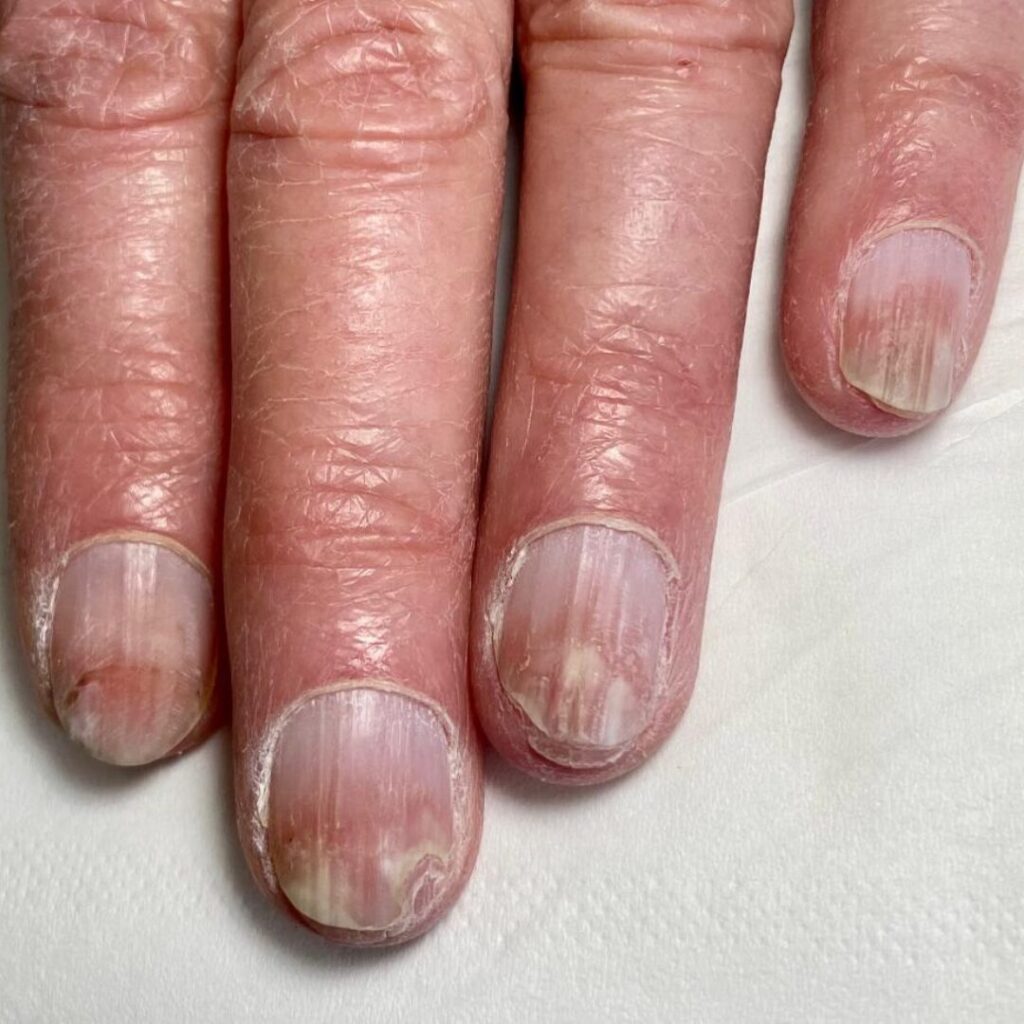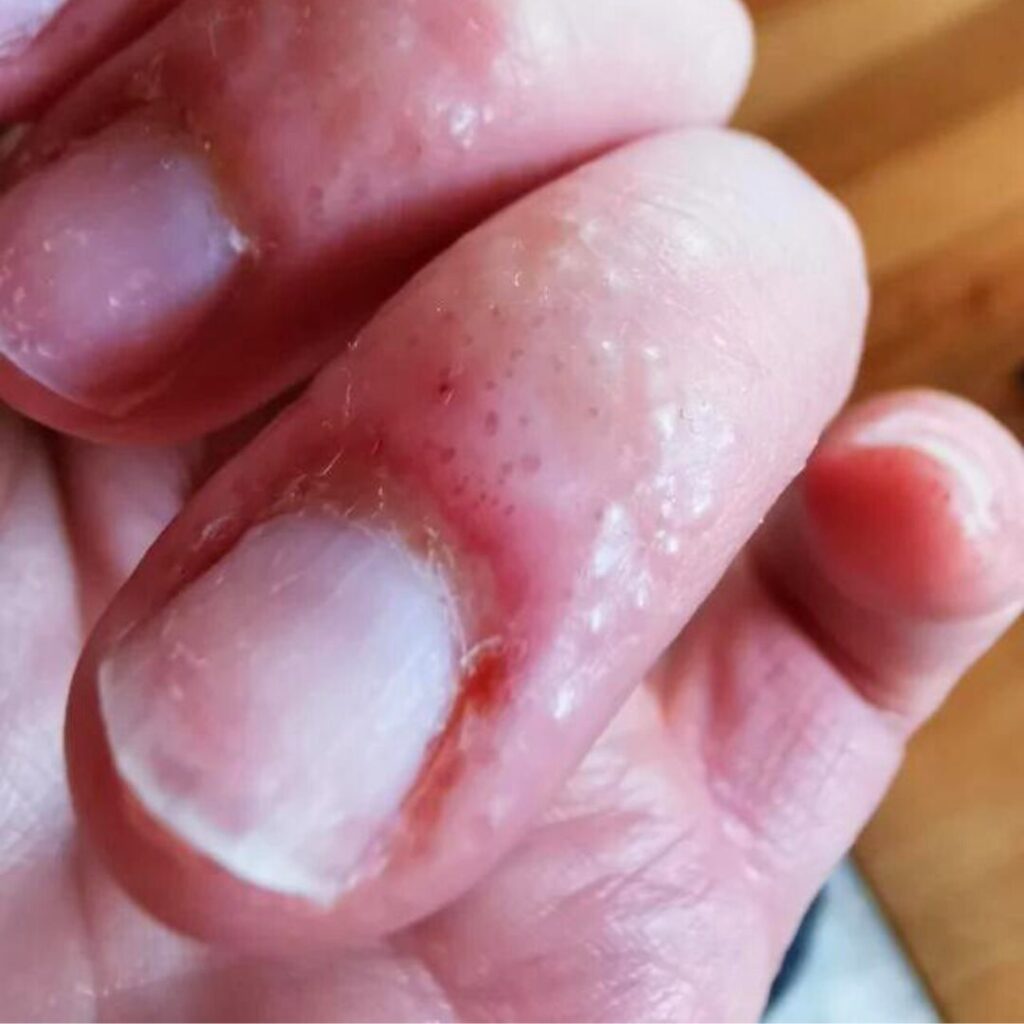NAIL ALLERGIES - SPREADING FEAR WITHOUT THE FIX by Theresa Foddering - The Naildresser®️
Regularly, in fact daily, nail separation (onycholysis) images are posted to nail community forums for pleas of advice, and the instantaneous answer is “Allergy”. Just that one simple word. No questions, no context – just “Allergy!” But this word is loaded with fear, confusion, misunderstanding and mostly miseducation. Not to mention the plea for help is requested in a place where these misunderstandings are common throughout the community. Now, these forums are a great resource, a place of support and inspiration, but they can also have the opposite effect and spread the fear without the fix.
There are multiple causes of nail separation, allergy or irritation is not the only cause, and unfortunately, I do not have a big enough column to discuss them all. If you do not know these causes or can only turn to the afore-mentioned forums perhaps you need to consider the following: was your education of a good standard; is it time to update and refresh? One would hope that once you’ve completed your training you should leave fully equipped to understand and deal with such situations. It is just as important to understand the skin and body’s functions as it is the anatomy of the nail unit.
But do you really know the difference between an irritation and an allergy? Unfortunately, they present themselves in the same way. The only difference is that an allergy is for life. An irritation when continuously irritated over a prolonged amount of time will become an allergy. So instead of instantly thinking the worst, take a moment to process the situation and take the irritation as a warning. Skin irritation or contact irritant dermatitis results from contact with a substance known as the irritant, and we must remember that all nail products are irritants, designed for application to healthy nails and not to make contact with the skin. When irritated, inflammation and damage to the skin surface will be present while the body’s own natural repair mechanisms defend, protect, and repair the skin. A skin irritation is usually limited to the specific site of direct contact, whereas an allergic reaction can cause symptoms to appear in different areas all over the body. But do not forget we touch our faces and body with our hands – so it’s just as easy to spread irritation further!

“Allergic contact reactions are less common than irritant reactions. To have an allergic response, the immune system needs to be involved, which explains why some people will develop allergies to a given substance and others never will; we all have a different genetic make-up.” Caroline Rainsford – Head of scientific & environmental services at the CTPA
What can you do to avoid causing an irritation or allergy?
To become over-exposed to a product and develop a lifelong allergy it usually means that there has been prolonged and repetitive contact with the skin.
The main reasons for this happening are:
· Uncured or under-cured product due to incorrect cure time or using the incorrect lamp
· Improper or careless application
· Uncured dust debris, this can happen when filling an under cured nail or when performing a soak off/removal of product
· Wiping the sticky residue (inhibition layer) from gels incorrectly. This also includes ‘no wipe’ formulas, they still have an element of uncured gel that remains on the surface unless wiped.
· Damage, such as intrusive cuticle prep, over filing of the nail plate, and aggressive removal techniques – all of which cause the nail to no longer be healthy and therefore penetrable to the allergens within nail products
So, what can you do to avoid causing these irritations?
· Use the correct matched lamp for your brand system
· Use brands together in full and do not mix incomplete systems
· Do not touch uncured product with your skin
· Wear gloves
· Invest in dust & vapour collection and ventilation
· Change/clean your desk tissue at regular intervals in the service thus keeping your working area clean and dust free
· Keep your bottle necks & handles clean & free from residue gel or product, preventing transfer of uncured product to skin, utensils, furnishings etc.
· Use legal, professional registered products avoiding everyday consumer sites
*As Nail Professionals whilst we cannot diagnose nor treat, we must always halt any service with any presented irritations and refer to the GP
accordingly.
But you’ll be fine if you use a HEMA-free, hypoallergenic brand, right?
Because of media created fear and a widespread confusion, professionals in recent times have searched for alternatives to HEMA based products immediately, and brands have also felt pressure to meet the demands of the professionals’ panic with ‘free from’ products.
Products that have been safely used, which contain allergenic chemicals, for decades are now questioned. They have always been safely used for a reason, and education was key to this safe practice. Education has shifted and is in many situations less thorough and a one training fits all mindset has not helped. But now there is a lot of focus on the formulas and blame of the chemicals without really having the underlying knowledge when training in the first place. Social media is now the new outlet of right & wrong, some may even dare say education. “Instagram said HEMA was bad, so I need to rebrand”.
HEMA is a chemical that has strong adhesion properties, hence its presence in nail products, you will also find it widely used in the medical industry such as dentistry. Due to it being a known allergen it became somewhat demonised, and at times used as a marketing agenda, despite its safe and wide usage for many years. Cheaper off the shelf brands sometimes contain very high levels of HEMA, albeit still within the recommended limit, providing the user with unrivalled adhesion with very little skill required or recognising safe working practices.
Hypoallergenic claims give the impression that they guarantee a complete absence of risk of a reaction, but this is not true. No brand or product can guarantee such claims and different individuals may react to different substances to different extents, and no manufacturer can guarantee that the user is following their recommended guidelines of use.
Hypoallergenic cosmetics are products that manufacturers or brands claim produce less or even no allergic reactions than other products or brands. Users will then assume that these products will be gentler to their skin, and therefore ‘safer’. However, there are no standards or laws that regulate the use of the term.
“The term means whatever a particular company wants it to mean.” – FDA

Get Educated!
Whilst allergies do exist, what you see most days is not an allergy, it’s most likely a fixable issue, an irritation – an early warning. Surely this is a much better scenario to be in than at point of no return. Stop and think! You invest so much when purchasing your chosen brand or getting every new release, why not spend the little extra and learn how to use them safely and within the specific manufacturer’s guidelines. Gain the knowledge to understand your products, and their application techniques, inside and out. Update and elevate yourself, be the best of the best! Thinking a product is not of a good standard just because of one chip or an issue on your first use, yet you have not learned all the correct properties or methods, is a huge waste of your money.
If you decide to jump onto a different brand because of an issue and repeat the same working processes, you will simply take the problems with you.
You may even seek advice in a forum asking if anyone else has experienced the same, but you very well may be asking an audience who too have tried the product once and ‘wrote it off’ without any knowledge or education. Reach out to the brand, you invested your money in – they must return that investment in support of you!
Education is invaluable, it may just save your clients nails or even your entire career.
Theresa Foddering – The Naildresser®️

